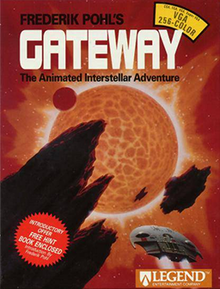Setting
A century in the future, humans land on Venus and colonize it. Below the surface, thousands of miles of artificial tunnels are discovered. They are believed to have been built thousands of years ago by an alien species known as the Heechee, but little else is known about them until an explorer discovers a Heechee ship, intact and operational, in one of the tunnels.
Rather than report his findings, he climbs in and activates it. The ship launches and goes into "TAU Space," a faster-than-light travel method. It arrives at a huge space station carved out of an asteroid floating halfway between Venus and Mercury, which is full of thousands of similar ships, but otherwise empty. However, the explorer is unable to figure out how to return to Venus, and faced with a lack of supplies, figures out how to detonate the fuel cell of the ship he came in. The detonation kills him, but also attracts the attention of a NASA tracking station, who send an expedition to investigate.
The discovery of the station and its ships allow humanity to travel into deep space. Although they were unable to reverse engineer the Heechee technology, they can use the ships' stored destinations and the station becomes humanity's "Gateway" to outer space, hence the name. This almost leads to war among the superpowers of Earth over ownership, until a compromise is finally worked out. A co-operative called the Gateway Corporation is formed, with the superpowers each holding one quarter of company stock.
The alien ships that are found still function, but their built-in destinations are a mystery. Navigation is accomplished by using 5 digit codes with the ships' computers, but there is no way to tell what codes go where. Volunteers called prospectors come to Gateway to test the codes and pilot the ships to their destination, explore and report back what they find (as well as bring anything interesting back). A large majority of the prospectors return with little or nothing, a tenth never return, but the remaining 1.5% return with artifacts or knowledge that make them incredibly rich.
Plot
The player character has won a one-way ticket to Gateway, membership as a prospector in the Gateway Corporation and 10 days of provided life support along with a small amount of money. The player begins as a Prospector and follows procedures in order to know Gateway better and afterwards begin exploring Heechee coordinates. The findings are important enough to get him secure 'Green Badge' status; prospectors of that status are sent to explore only known destinations, with considerably higher probabilities of Heechee finds.
Exploration in one such planet brings a Heechee 'computer' which makes him rich; however, after being analyzed by the Gateway Corporation, it reveals that a hostile alien race, dubbed the Assassins threatens all advanced civilizations in the universe, and the Heechee managed to evade them. Leonard Worden, the deputy chief of the exploration program, informs the player that even after all those years, reactivation of the Heechee technology by humans would only make them detectable to the Assassins. However the same computer provides coordinates to an interplanetary shield device.
The game plot then sends the player to four planets in order to activate a shield device that would 'cloak' the technology signal from the Assassins.
The game's climax occurs on a world of the Assassins, dubbed "Watchtower" where the player is sent to activate the mechanism. There he will meet a Heechee artificial intelligence entity and also an electronic Assassin entity which will trap the player in a VR environment. Following the Heechee AI's guidance, the player is tasked to escape them by creating paradoxes and afterwards upload the Heechee AI.
The game ends with the player's return as a hero and the fear that the threat of the Assassins still exists.

